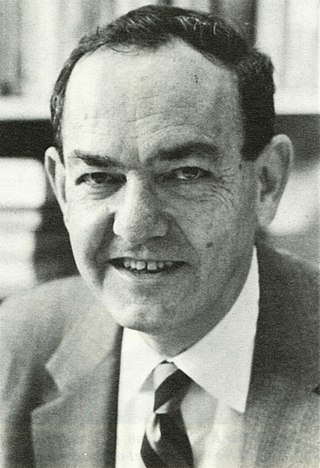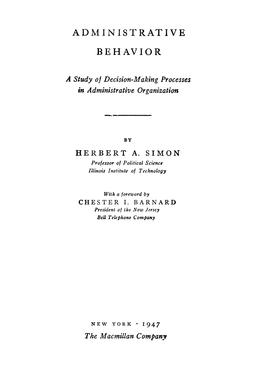
Herbert Alexander Simon was an American political scientist whose work also influenced the fields of computer science, economics, and cognitive psychology. His primary research interest was decision-making within organizations and he is best known for the theories of "bounded rationality" and "satisficing". He received the Nobel Memorial Prize in Economic Sciences in 1978 and the Turing Award in computer science in 1975. His research was noted for its interdisciplinary nature, spanning the fields of cognitive science, computer science, public administration, management, and political science. He was at Carnegie Mellon University for most of his career, from 1949 to 2001, where he helped found the Carnegie Mellon School of Computer Science, one of the first such departments in the world.

Microeconomics is a branch of economics that studies the behavior of individuals and firms in making decisions regarding the allocation of scarce resources and the interactions among these individuals and firms. Microeconomics focuses on the study of individual markets, sectors, or industries as opposed to the national economy as a whole, which is studied in macroeconomics.
Rational choice theory refers to a set of guidelines that help understand economic and social behaviour. The theory originated in the eighteenth century and can be traced back to the political economist and philosopher Adam Smith. The theory postulates that an individual will perform a cost–benefit analysis to determine whether an option is right for them. Rational choice theory looks at three concepts: rational actors, self interest and the invisible hand.
Bounded rationality is the idea that rationality is limited when individuals make decisions, and under these limitations, rational individuals will select a decision that is satisfactory rather than optimal.
Satisficing is a decision-making strategy or cognitive heuristic that entails searching through the available alternatives until an acceptability threshold is met. The term satisficing, a portmanteau of satisfy and suffice, was introduced by Herbert A. Simon in 1956, although the concept was first posited in his 1947 book Administrative Behavior. Simon used satisficing to explain the behavior of decision makers under circumstances in which an optimal solution cannot be determined. He maintained that many natural problems are characterized by computational intractability or a lack of information, both of which preclude the use of mathematical optimization procedures. He observed in his Nobel Prize in Economics speech that "decision makers can satisfice either by finding optimum solutions for a simplified world, or by finding satisfactory solutions for a more realistic world. Neither approach, in general, dominates the other, and both have continued to co-exist in the world of management science".
Behavioral economics is the study of the psychological, cognitive, emotional, cultural and social factors involved in the decisions of individuals or institutions, and how these decisions deviate from those implied by classical economic theory.
Organizational learning is the process of creating, retaining, and transferring knowledge within an organization. An organization improves over time as it gains experience. From this experience, it is able to create knowledge. This knowledge is broad, covering any topic that could better an organization. Examples may include ways to increase production efficiency or to develop beneficial investor relations. Knowledge is created at four different units: individual, group, organizational, and inter organizational.
In the field of management, strategic management involves the formulation and implementation of the major goals and initiatives taken by an organization's managers on behalf of stakeholders, based on consideration of resources and an assessment of the internal and external environments in which the organization operates. Strategic management provides overall direction to an enterprise and involves specifying the organization's objectives, developing policies and plans to achieve those objectives, and then allocating resources to implement the plans. Academics and practicing managers have developed numerous models and frameworks to assist in strategic decision-making in the context of complex environments and competitive dynamics. Strategic management is not static in nature; the models can include a feedback loop to monitor execution and to inform the next round of planning.

X-inefficiency is a concept used in economics to describe instances where firms go through internal inefficiency resulting in higher production costs than required for a given output. This inefficiency is a result of various factors such as outdated technology, inefficient production processes, poor management and lack of competition resulting in lower profits and higher prices for consumers. The concept of X-inefficiency was introduced by Harvey Leibenstein.

Organizational theory refers to a series of interrelated concepts that involve the sociological study of the structures and operations of formal social organizations. Organizational theory also seeks to explain how interrelated units of organization either connect or do not connect with each other. Organizational theory also concerns understanding how groups of individuals behave, which may differ from the behavior of an individual. The behavior organizational theory often focuses on is goal-directed. Organizational theory covers both intra-organizational and inter-organizational fields of study.
Managerial economics is a branch of economics involving the application of economic methods in the organizational decision-making process. Economics is the study of the production, distribution, and consumption of goods and services. Managerial economics involves the use of economic theories and principles to make decisions regarding the allocation of scarce resources. It guides managers in making decisions relating to the company's customers, competitors, suppliers, and internal operations.

James Gardner March was an American political scientist, sociologist, and economist. A professor at Stanford University in the Stanford Graduate School of Business and Stanford Graduate School of Education, he is best known for his research on organizations, his seminal work on A Behavioral Theory of the Firm, and the organizational decision making model known as the Garbage Can Model.
Organizational behavior or organisational behaviour is the: "study of human behavior in organizational settings, the interface between human behavior and the organization, and the organization itself". Organizational behavioral research can be categorized in at least three ways:
The theory of the firm consists of a number of economic theories that explain and predict the nature of the firm, company, or corporation, including its existence, behaviour, structure, and relationship to the market. Firms are key drivers in economics, providing goods and services in return for monetary payments and rewards. Organisational structure, incentives, employee productivity, and information all influence the successful operation of a firm in the economy and within itself. As such major economic theories such as transaction cost theory, managerial economics and behavioural theory of the firm will allow for an in-depth analysis on various firm and management types.
Organizational effectiveness is a concept organizations use to gauge how effective they are at reaching intended outcomes. Organizational effectiveness is both a powerful and problematic term. It may be used to critically evaluate and improve organizational activities; this is one of its strengths. However, the term has been noted as problematic as it means various things to different individuals. Furthermore, there are alternative methods for measuring organizational performance. Organizational effectiveness embodies the degree to which firms achieve the goals they have decided upon, a question that draws on several different factors. Among those are talent management, leadership development, organization design and structure, design of measurements and scorecards, implementation of change and transformation, deploying smart processes and smart technology to manage the firm's human capital and the formulation of the broader Human Resources agenda.
Richard Michael Cyert was an American economist, statistician and organizational theorist, who served as the sixth President of Carnegie Mellon University in Pittsburgh, Pennsylvania, United States. He is known for his seminal 1959 work "A behavioral theory of the firm," co-authored with James G. March.
The Carnegie School is a school of economic thought originally formed at the Graduate School of Industrial Administration (GSIA), the current Tepper School of Business, of Carnegie Institute of Technology, the current Carnegie Mellon University, especially during the 1950s to 1970s.

Administrative Behavior: a Study of Decision-Making Processes in Administrative Organization is a book written by Herbert A. Simon (1916–2001). It asserts that "decision-making is the heart of administration, and that the vocabulary of administrative theory must be derived from the logic and psychology of human choice", and it attempts to describe administrative organizations "in a way that will provide the basis for scientific analysis". The first edition was published in 1947; the second, in 1957; the third, in 1976; and the fourth, in 1997. As summarized in a 2001 obituary of Simon, the book "reject[ed] the notion of an omniscient 'economic man' capable of making decisions that bring the greatest benefit possible and substitut[ed] instead the idea of 'administrative man' who 'satisfices—looks for a course of action that is satisfactory'". Administrative Behavior laid the foundation for the economic movement known as the Carnegie School.
Maximization is a style of decision-making characterized by seeking the best option through an exhaustive search through alternatives. It is contrasted with satisficing, in which individuals evaluate options until they find one that is "good enough".
Behavioral strategy refers to the application of insights from psychology and behavioral economics to the research and practice of strategic management. In one definition of the field, "Behavioral strategy merges cognitive and social psychology with strategic management theory and practice. Behavioral strategy aims to bring realistic assumptions about human cognition, emotions, and social behavior to the strategic management of organizations and, thereby, to enrich strategy theory, empirical research, and real-world practice".






